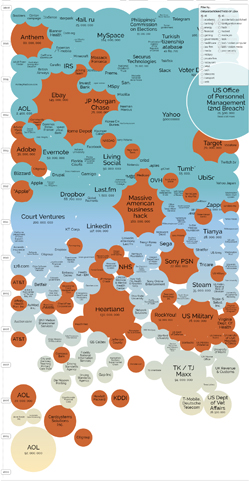6 of 10 Companies Approve BYOD
April 18, 2013 by admin
Filed under Around The Net
Comments Off on 6 of 10 Companies Approve BYOD
More than six out of 10 companies allow or mandate the use of employee-owned mobile devices for work in order to increase productivity, according to a survey published on Tuesday.
While the BYOD (bring your own device) push has been at the forefront of press coverage, the majority of companies still provide at least a subset of devices to employees. One third of companies strictly mandate which devices can be used for work purposes and don’t allow any type of device provided by the employee, according to the survey conducted by the Computing Technology Industry Association (CompTIA), a nonprofit trade group.
The online survey of 502 U.S. IT and business executives was conducted in February. It also found that the most popular option, at 58%, was to have a mix of corporate-owned and employee-owned devices.
For 53% of those surveyed, the top reason for allowing employees to use or select their own devices was to increase productivity while employees are away from the office. Another reason was that employees like to use familiar devices.
Twelve percent of the respondents stated it was simply too difficult to stop employees from using their own devices.
CompTIA’s report said that companies looking to maximize the benefits of a mobile device-enabled workforce must “look beyond simply which devices are used and re-examine business processes and workforce needs.”
Companies should assess the specific needs of workers, rather than just deploying one device over another on a corporate-wide basis, said Seth Robinson, director, technology analysis, at CompTIA.
IBM’s Next-gen Transistors Mimick Human Brain
Comments Off on IBM’s Next-gen Transistors Mimick Human Brain
IBM has discovered a way to make transistors that could be turned into virtual circuitry that mimics how the human brain operates.
The new transistors would be made from strongly correlated materials, such as metal oxides, which researchers say can be used to build more powerful — but less power-hungry — computation circuitry.
“The scaling of conventional-based transistors is nearing an end, after a fantastic run of 50 years,” said Stuart Parkin, an IBM fellow at IBM Research. “We need to consider alternative devices and materials that operate entirely differently.”
Researchers have been trying to find ways of changing conductivity states in strongly correlated materials for years. Parkin’s team is the first to convert metal oxides from an insulated to conductive state by applying oxygen ions to the material. The team recently published details of the work in the journal Science.
In theory, such transistors could mimic how the human brain operates in that “liquids and currents of ions [would be used] to change materials,” Parkin said, noting that “brains can carry out computing operations a million times more efficiently than silicon-based computers.”
Windows RT Devices To Drop In Price
Prices of Windows RT devices have started to decline, signaling an attempt by PC makers to quickly clear out stock after poor adoption of tablets and convertibles with the operating system.
Microsoft released Windows RT for ARM-based devices and Windows 8 for Intel-based devices in October last year. The price drop is an acknowledgement that Windows RT has failed, analysts said.
Prices of popular products usually don’t fall, but Windows RT devices were not in demand, and prices fell, analysts said.
The starting price for Dell’s XPS 10 is now US$449 for a 32GB model, scalping $50 off the original launch price. The 64GB model is $499, which is a drop from the original $599 price. By comparison, the price of the Latitude 10 tablet with Intel processors and Microsoft’s Windows 8 OS remained stable at $499.
Asus’ VivoTab RT, which is largely sold through retailers, is being offered by Amazon.com for $382 with 32GB of storage, which is a heavy discount from the $599 launch price. Retailers like Best Buy, Staples and Office Depot have also dropped the price of the tablet by $50, now selling it for $549.
Newegg is listing VivoTab RT as having been discontinued. Asus did not respond to a request to comment on whether the company was still offering the tablet.
Lenovo is offering the IdeaPad Yoga 11 for $599 as part of a seven-day deal, which is a drop from the original $799 price. However, TigerDirect is offering an IdeaPad Yoga 11 model for $599 on its website, while Amazon is selling a model for $499.99.
Samsung did not ship its Windows RT tablet, Ativ Tab, to the U.S. market.
However, the starting price of Microsoft’s Surface RT remained consistent at $499 on its online store. Microsoft also offers Lenovo’s IdeaPad Yoga 11 through its store, but has stopped offering tablets like the VivoTab RT on its website. The company last month said it stocks its store with RT devices based on availability and demand.
3G And 4G Modems Pose Security Threats
Researchers Nikita Tarakanov and Oleg Kupreev analyzed the security of 3G/4G USB modems obtained from Russian operators for the past several months. Their findings were presented Thursday at the Black Hat Europe 2013 security conference in Amsterdam.
Most 3G/4G modems used in Russia, Europe, and probably elsewhere in the world, are made by Chinese hardware manufacturers Huawei and ZTE, and are branded with the mobile operators’ logos and trademarks, Tarakanov said. Because of this, even if the research was done primarily on Huawei modems from Russian operators, the results should be relevant in other parts of the world as well, he said.
Tarakanov said that they weren’t able to test baseband attacks against the Qualcomm chips found inside the modems because it’s illegal in Russia to operate your own GSM base station if you’re not an intelligence agency or a telecom operator. “We’ll probably have to move to another country for a few months to do it,” he said.
There’s still a lot to investigate in terms of the hardware’s security. For example, the SoC (system on a chip) used in many modems has Bluetooth capability that is disabled from the firmware, but it might be possible to enable it, the researcher said.
For now, the researchers tested the software preloaded on the modems and found multiple ways to attack it or to use it in attacks.
For one, it’s easy to make an image of the USB modem’s file system, modify it and write it on the modem again. There’s a tool available from Huawei to do modem backup and restore, but there are also free tools that support modems from other manufacturers, Tarakanov said.
Malware running on the computer could detect the model and version of the active 3G modem and could write an image with malicious customizations to it using such tools. That modem would then compromise any computer it’s used on.
The researchers also found a possible mass attack vector. Once installed on a computer, the modem application — at least the one from Huawei — checks periodically for updates from a single server, Tarakanov said. Software branded for a specific operator searchers for updates in a server directory specific to that operator.
An attacker who manages to compromise this update server, can launch mass attacks against users from many operators, Tarakanov said. Huawei 3G modems from several different Russian operators used the same server, but there might be other update servers for other countries, he said.
Research in this area is just at the beginning and there’s more to investigate, Tarakanov said. Someone has to do it because many new laptops come with 3G/4G modems directly built in and people should know if they’re a security threat.
Is Non-Volatile Memory The Next Craze?
A report from analysts Yole Developpement claims that MRAM/STTMRAM and PCM will lead the Emerging Non-Volatile Memory (ENVM) market and earn a combined $1.6bn by 2018. If the North Koreans have not conquered America, by 2018 then MRAM/STTMRAM and PCM will surely be the top two ENVM on the market.
Yole’s Yann de Charentenay said that their combined sales will almost double each year, with double-density chips launched every two years. So far we have only had FRAM, PCM and MRAM to play with and they were available in low-density chips to only a few players. The market was quite limited and considerably smaller than the DRAM and flash markets which had combined revenues of $50bn+ in 2012, the report said. In the next five years the scalability and chip density of those memories will be greatly improved and will spark many new applications, says the report.
ENVM will greatly improve the input/output performance of enterprise storage systems whose requirements will intensify with the growing need for web-based data supported by cloud servers, the report said. Mobile phones will increase its adoption of PCM as a substitute to flash NOR memory in MCP packages thanks to 1GB chips made available by Micron in 2012, it added. The next milestone will be the higher-density chips, expected in 2015, will allow access to smart phone applications that are quickly replacing entry-level phones.
Will SSDs Make HD’s Obsolete?
 HD makers can expect to see revenues decline as demand for traditional disk drives falls, according to IHS Isuppli.
HD makers can expect to see revenues decline as demand for traditional disk drives falls, according to IHS Isuppli.
Hard drive manufacturers Seagate, Western Digital and Toshiba have carved up most of the market, lowering warranties and keeping prices high after the Thai floods in 2011 that shuttered several factories. Now IHS Isuppli claims that the good times have come to an end, with industry revenues expected to drop by 11.8 percent in 2013 and 2014 not expected to show signs of improvement.
While Seagate and Western Digital gouged consumers by keeping prices artificially high even after production recovered to pre-flood levels, solid-state disk (SSD) drive makers aggressively brought prices down. Intel has also been pushing SSDs as part of its ultrabook specification and with Windows 8 tablets using SSDs, the long term prospects for hard drive makers are not looking good.
Fang Zhang, analyst for storage systems at IHS Isuppli said, “The HDD industry will face myriad challenges in 2013. Shipments for desktop PCs will slip this year, while notebook sales are under pressure as consumers continue to favour smartphones and tablets. The declining price of SSDs also will allow them to take away some share from conventional HDDs. However, HDDs will continue to be the dominant form of storage this year, especially as demand for ultrabooks picks up and hard drives remain essential in business computing.”
IHS Isuppli said Western Digital could overtake Seagate to become the market share leader by the end of 2013, and said that hard drives will see greater use in the enterprise market in cloud and big data use cases.
Passwords Continue As The Weakest Link
Comments Off on Passwords Continue As The Weakest Link
 Passwords aren’t the only failure point in many recent widely publicized intrusions by hackers.
Passwords aren’t the only failure point in many recent widely publicized intrusions by hackers.
But passwords played a part in the perfect storm of users, service providers and technology failures that can result in epic network disasters. Password-based security mechanisms — which can be cracked, reset and socially engineered — no longer suffice in the era of cloud computing.
The problem is this: The more complex a password is, the harder it is to guess and the more secure it is. But the more complex a password is, the more likely it is to be written down or otherwise stored in an easily accessible location, and therefore the less secure it is. And the killer corollary: If a password is stolen, its relative simplicity or complexity becomes irrelevant.
Password security is the common cold of our technological age, a persistent problem that we can’t seem to solve. The technologies that promised to reduce our dependence on passwords — biometrics, smart cards, key fobs, tokens — have all thus far fallen short in terms of cost, reliability or other attributes. And yet, as ongoing news reports about password breaches show, password management is now more important than ever.
All of which makes password management a nightmare for IT shops. “IT faces competing interests,” says Forrester analyst Eve Maler. “They want to be compliant and secure, but they also want to be fast and expedient when it comes to synchronizing user accounts.”
Was The Prize Stock For 2012?
 If you wanted to know the IT company which was a rotten investment this year, you might be thinking Facebook, HP or RIM.
If you wanted to know the IT company which was a rotten investment this year, you might be thinking Facebook, HP or RIM.
However according to Business Insider is starting to look like the so-called industry leader, Apple might have caused its investors the biggest headaches. More money has been lost in the past three months in Apple stock than has ever been lost in the tech disasters known as Hewlett-Packard and Research In Motion combined.
HP’s stock price peaked above $50 a few years ago, and now it’s trading at $14 and RIM peaked above $140 a few years ago, and it’s trading for $11. However Jobs Mob’s share price peaked above $700 three months ago and is now trading just above $500. This means that on a percentage basis, therefore, Apple’s stock is down much less than either Hewlett-Packard RIM but has cost shareholders a lot more money.
When HP investors have lost about $100 billion since the 2000 peak and RIM has lost $65 billion since the 2000 peak. Apple has cost its shareholders value in three months. What is more amusing is that about four months ago, I was lectured by an Apple fanboy who told me that the company is going to be worth a trillion dollars by the end of the year and he just invested more than $100,000 in the company. Looks like he would have been better off putting it on a horse.
Is HP Getting Sued?
 HP is in the process of being sued by an angry investor who claims the company knew statements about its Autonomy acquisition were misleading and led the stock to fall.
HP is in the process of being sued by an angry investor who claims the company knew statements about its Autonomy acquisition were misleading and led the stock to fall.
A proposed class action lawsuit was filed in a San Francisco federal court. HP bought British software firm Autonomy for a $11.1 billion last year but made an $8.8 billion write-down on its acquisition claiming the company inflated sales with improper accounting.
Autonomy co-founder Mike Lynch has denied any wrongdoing. The lawsuit, one of the first to be filed by investors on the Autonomy mess, said HP hid the fact it gained control of Autonomy based on financial statements that could not be relied upon.
It claims HP had not revealed to investors that it tried to undo the Autonomy agreement before it closed because of the accounting issues.
Do Supercomputers Lead To Downtime?
 As supercomputers grow more powerful, they’ll also become more susceptible to failure, thanks to the increased amount of built-in componentry. A few researchers at the recent SC12 conference, held last week in Salt Lake City, offered possible solutions to this growing problem.
As supercomputers grow more powerful, they’ll also become more susceptible to failure, thanks to the increased amount of built-in componentry. A few researchers at the recent SC12 conference, held last week in Salt Lake City, offered possible solutions to this growing problem.
Today’s high-performance computing (HPC) systems can have 100,000 nodes or more — with each node built from multiple components of memory, processors, buses and other circuitry. Statistically speaking, all these components will fail at some point, and they halt operations when they do so, said David Fiala, a Ph.D student at the North Carolina State University, during a talk at SC12.
The problem is not a new one, of course. When Lawrence Livermore National Laboratory’s 600-node ASCI (Accelerated Strategic Computing Initiative) White supercomputer went online in 2001, it had a mean time between failures (MTBF) of only five hours, thanks in part to component failures. Later tuning efforts had improved ASCI White’s MTBF to 55 hours, Fiala said.
But as the number of supercomputer nodes grows, so will the problem. “Something has to be done about this. It will get worse as we move to exascale,” Fiala said, referring to how supercomputers of the next decade are expected to have 10 times the computational power that today’s models do.
Today’s techniques for dealing with system failure may not scale very well, Fiala said. He cited checkpointing, in which a running program is temporarily halted and its state is saved to disk. Should the program then crash, the system is able to restart the job from the last checkpoint.
The problem with checkpointing, according to Fiala, is that as the number of nodes grows, the amount of system overhead needed to do checkpointing grows as well — and grows at an exponential rate. On a 100,000-node supercomputer, for example, only about 35 percent of the activity will be involved in conducting work. The rest will be taken up by checkpointing and — should a system fail — recovery operations, Fiala estimated.
Because of all the additional hardware needed for exascale systems, which could be built from a million or more components, system reliability will have to be improved by 100 times in order to keep to the same MTBF that today’s supercomputers enjoy, Fiala said.
Fiala presented technology that he and fellow researchers developed that may help improve reliability. The technology addresses the problem of silent data corruption, when systems make undetected errors writing data to disk.








 Sign up for our Technology Newsletter
Sign up for our Technology Newsletter